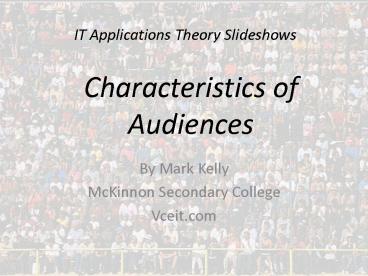IT Applications Theory Slideshows - PowerPoint PPT Presentation
1 / 27
Title:
IT Applications Theory Slideshows
Description:
In publishing, the audience is the group of people who are expected to read, see ... Very hard to craft your material to suit everyone ... – PowerPoint PPT presentation
Number of Views:80
Avg rating:3.0/5.0
Title: IT Applications Theory Slideshows
1
IT Applications Theory Slideshows
Characteristics of Audiences
- By Mark Kelly
- McKinnon Secondary College
- Vceit.com
2
Audience?
- In publishing, the audience is the group of
people who are expected to read, see or listen to
your publication. - Sometimes you will accurately know the nature and
needs of your audience - This makes publishing a heck of a lot easier.
- Can tailor the material to suit the audience.
3
For Example
- Mr Bozo, the clown is not going to lose sleep
trying to figure out the content of his material
for that 4 year old girl's party tomorrow. - Neither will Mr Bozo be in much doubt about how
he should present his material.
4
The audience affects
- The content (the topics covered, and the level of
detail) - The manner of presentation (e.g. vocabulary
choices)
5
A General Audience
- Could contain any sort of people.
- Very hard to craft your material to suit everyone
- Need to be careful not to offend, confuse, bore
or alienate people.
6
Characteristics
- Audiences can be categorised by many different
characteristics those features that make them
different to other people. - Is important to keep the characteristics and
needs of your audience in mind.
7
Knowledge levels
- A lecture for surgeons would not have to explain
what a scalpel is. - For kids, you would explain it.
- Would foreigners understand references to Ned
Kelly or footy?
8
- Interest levels
- some audiences are captive and must pay attention
to a publication (e.g. students in class) - But most audiences are voluntary to some degree
- If their needs are not considered,they will turn
off or walk out
9
Criteria for Success
- Information presentations (slideshows, films,
databases, ads, animations, websites anything!)
must be judged by how well they communicate their
information to the audience - If the audience ignores it, or walks out, the
presentation is a failure regardless of its
beauty or technical brilliance.
10
A reluctant audience
- If your audience is reluctant to pay attention
(e.g. year 12 ITA students), you need to take
this into account - And to keep them engaged you might need to do
things like
11
THIS
12
OR THIS
13
- language skills
- Many publications (especially on the web) have
international audiences - Not everyone speaks English well or at all
- For many people, English is a second language
- Dont assume all members of your audiences
speak fluent English, or know big words.
14
Language skills
- Choose small words when you can
- Use simple sentences
- Short
- One main idea
- No complex or obscure grammar
- Avoid local idioms e.g. slang, local knowledge
- Accurate spelling
- Accurate punctuation
15
- Age
- people of different ages are attracted to and
interested by different things - some topics are unpleasant, irrelevant or
unsuitable for people of certain ages.
16
SEX
17
- Males and females are different
- You might have noticed already
- Compare products (e.g. phones, cars) marketed to
one gender or the other - Advertisers know how to target each sex
18
Activity
- Find one ad for a vehicle that is clearly aimed
at women buyers. - Find another ad for a car that is clearly aimed
at male buyers. - What differences are there in terms of the
content and appearance of the ads?
19
What to do
- Avoid gender stereotypes
- Dont insult either sex
- Be sensitive to the fact that some cultures,
treat males and females very differently
20
- Information needs
- different types of people need to know different
things, in different levels of detail. - Too much information boredom
- Too little information confusion
- Wrong selection of information irrelevance
21
- Special needs
- Colour blind
- Vision-impaired
- Hearing-impaired
- Intellectually-impaired
- Attention Deficit Disorder
- Poor coordination, etc.
- May be impossible to cater to them all
- But dont make it unnecessarily hard for them
either (e.g. poor colour contrast, mumbling
voice, tiny buttons)
22
- Culture and background
- Not everyone is like you.
- What is normal to you is not normal for everyone,
e.g. date formats, commas in numbers,
abbreviations, slang terms.
Q. Which of these trucks is abnormal?
23
- Culture and background
- Some beliefs are powerfully held
- Some words or concepts are hateful to some
groups. - Dont joke about politics, sex or religion
24
Then
- 2) What are their information needs?
- What do they need to know?
- What topics to cover?
- How much detail to go into?
25
Then
- 3) How can you best present the information to
them? - Format?
- Book? Poster? Slideshow? Web site? Film or
animation? A combination of these? - Style?
- Funny? Serious? Decorative? Plain? Big print?
Colour scheme? - Language?
- Simple or sophisticated? Jargon?
26
If possible
- Test the material with a representative sample
audience before subjecting the whole audience to
it.
27
IT APPLICATIONS SLIDESHOWS
- By Mark Kelly
- McKinnon Secondary College
- vceit.com
These slideshows may be freely used, modified or
distributed by teachers and students anywhere on
the planet (but not elsewhere). They may NOT be
sold. They must NOT be redistributed if you
modify them.































